Lunosemyannik Daurian, Diseases and treatment of folk and drugs. Description, use and healing properties of herbs, alternative medicine. Lunosemyannik Daurian. Growing experience in Siberia.
This is a beautiful climbing plant. - Liana, also called Amur ivy - grows in wild form along the Amur River south of Khabarovsk, in the southern regions of Eastern Siberia and in the west reaches Minusinsk on the Yenisei River, also grows in China and on the Korean peninsula. Most often lives on the forest edges and on rivers, twisting around shrubs and tall grasses.
Not recommended destructive collection of rhizomes: although the plant is not currently rare, intensive collection may entail a reduction in the number of species. Part of the population is located on the territory of the Pribaikalsky Natural National Park.
Lunosemyannik- perennial dioecious herbaceous plant with green stems, dying off to the ground for the winter. Rhizome long, with thin roots. The leaves are beautiful, alternate, petiolate, rounded in general outline, unclearly three to five-lobed, resembling ivy. Racemes inflorescences, bearing up to 30 flowers. Flowers same-sex, small, greenish, staminate and pistillate flowers develop on different individuals. Pistillate specimens are very decorative in the autumn, when black spherical drupe fruits appear. The stone is large, semi-lunar form (whence the name of the plant), with a ribbed outer edge. Blossoms in May, fruits in September.
For medicinal purposes, rhizomes with roots are collected. The whole plant contains alkaloids. In the rhizomes with roots of 0.5-1%, mainly dauritsin, in the aerial parts - up to 1% (synomenin and acutumin). The preparation of rhizomes with roots has a hypotensive effect.
In folk medicine Transbaikalia Lunosemyanik grass is used for gynecological diseases, febrile conditions, as a diaphoretic, expectorant, for pneumonia, diarrhea. Tincture of the roots was used as a means of tonic activity of the gastrointestinal tract, which improves metabolism, in cholecystitis and endometritis. Lunosemnik grass is used in Chinese and Tibetan medicine as an analgesic and diuretic, for nephritis, etc. A piece of lunosean root is applied to a sick tooth for toothache.
Lunosemyanniki berries are poisonous, so when harvesting plants they should beware, as when they are eaten, a rather persistent circulatory failure develops with a very severe general condition.
Tincture and decoction of the roots and rhizomes of the Lunosemyanika have a calming effect, reduce blood pressure, improve the efficiency and well-being of patients, reduce headaches and reduce the excitability of the autonomic nervous system. Clinical trials of dauricin isolated from the rhizomes of the plant have shown its effectiveness in stage I and stage II hypertension. At the same time, in some patients who had pronounced sclerotic changes in the blood vessels, under the influence of the drug, the amount of cholesterol decreased and the amount of lecithin in the blood increased.
Broth: 4-8 g of dry rhizomes and roots of a Lunosemyannik are boiled for 500 ml of water for 10 minutes, infused for 30 minutes, filtered. Take 100 ml 3-4 times a day for acute respiratory diseases, tonsillitis, gum disease, furunculosis, hemorrhoids, as well as for intestinal diseases.
Tincture: the roots and rhizomes of the Lunoseminnik insist on alcohol (1: 8) for 15 days, filter. Take 15-20 drops for hypertension.
Oil: crushed Lunosemyanik, mixed with vegetable oil, applied to the temples with a headache.
Lunosemyannik widely used in ornamental horticulture for planting walls, arbors. Unusually picturesque green garlands of intertwining stalks of moonseeding between trees and shrubs.
This medicinal plant contains in its composition alkaloids dauricin, tetrandrin, synomenin, tannins, resins, coumarins and saponins. For therapeutic purposes, use the roots and rhizomes of the Lunosemyannika, less often - grass and leaves. The underground part of the plant is collected in the fall (in October), the above-ground part - in May-June. The roots are cleaned from the remnants of the earth and pieces of stems, washed in water and dried under a canopy in the open air or in well-ventilated areas. Grass and leaves are dried without washing, in the usual way.
Lunosemyanika application
Scientific studies have found that decoctions and tinctures of the rhizomes of the plant reduce blood pressure, have a calming effect, improve the well-being and performance of patients. Lunosemyanniki drugs reduce the symptoms and reduce the excitability of the autonomic nervous system.
Due to the content of the alkaloid dauricin isolated from the roots, Lunosemyanika-based drugs are also effective in hypertension stage I and II. In patients with already existing sclerotic vascular changes under the action of decoctions and infusions of a moonsemy, the amount decreases and the amount of lecithin in the blood increases. Thanks to synomenin, the plant's preparations help well at high temperatures. They have antitussive action and have anti-inflammatory effect. Lunosemyannik has good prospects as a remedy for treatment, abscesses, and back pain.
In folk medicine, herb prescribed for febrile conditions, gynecological diseases, as well as expectorant and diaphoretic; It is used for pneumonia. Tincture of the roots is used as a means of improving metabolism and tonic activity of the stomach and intestines, it is effective for cholecystitis and endometritis. Also, the herb is used as a painkiller and diuretic.
Lunosemyan broth:2 teaspoons of dried and chopped rhizomes need to be poured over with two 2 cups boiling water and cook on low heat for 10–12 minutes, insist for at least half an hour and strain. Take the drug advised three times a day and 1 tablespoon.
Lunosemyanika infusion:2 tablespoons of finely chopped dry leaves of the plant should be poured with a glass of boiling water, infused for at least two hours to cool completely, drain. Take the infusion three times a day at 0.25 ml.
Found a mistake in the text? Select it and a few more words, press Ctrl + Enter
Lunosemyannik Dauri
It is a curly grassy shrub. Rhizome he has a vertical, non-thick. Smooth stems up to three meters high annually partially die. Beautiful leaves are arranged alternately on long petioles. Leaf blade ovate, three-five-lobe with a triangular tip. The flowers are small, inconspicuous, dioecious, same-sex, greenish-white, grow in small racemes.
This species of lunacean blooms from June to July, the seeds ripen in September. Its fruit is a black berry with a large single seed in the shape of the moon. The plant propagates by dividing rhizomes, layering and seeds. In the wild it grows in the Far East, in China and Japan. The plant hovers around high grasses and shrubs, on sand, scree along the banks of rivers.
Contraindications Lunosemyannika
In the Lunosemyanika all parts are poisonous, and the underground is much larger than the aboveground. That is why the use of drugs from it requires caution, accurate dosage and consultation with a doctor.
Symptoms of poisoning berries: nausea, indigestion, in severe cases - cardiovascular failure. The patient should immediately wash the stomach with a solution of potassium permanganate or activated charcoal. Contraindications to the use of the plant are individual intolerance, pregnancy and breastfeeding.
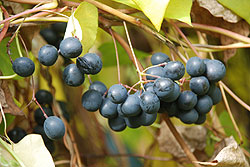
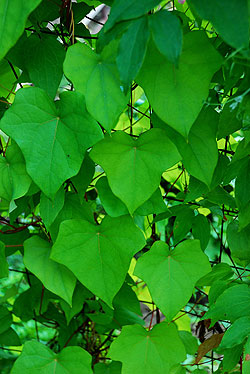
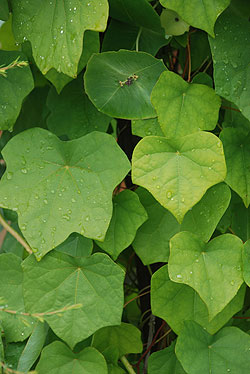

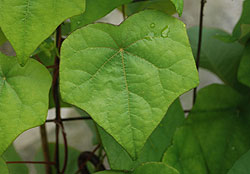
Observations of garden plants give a lot of interesting things. Here, for example, Lunosemyannik Dauri (Menispermum dahuricum), he, by the way, appeared in our garden in 2001. And he arrived from the district center Rodniki, Ivanovo region, from the famous plant lover A.A. Saleyev.
Scientists books in one voice say that this vine is dioecious. Clearly, if you have only one instance in your garden, there is no point in hoping for fruit. They simply have nowhere to appear: a male plant does not produce them, and a female without a male can not.
But one can see the immaculate conception, not at all fiction, - not a figment of invention. It happens.
Amur ivy in front and profile.
Lunosemyannik Daurian is a climbing shrub liana. This means that its shoots are partially woody, and partially remain grassy. In practice, it all depends on age. Annual shoots are as thin as shoelaces, and completely grassy. With age, the creepers of lianas thicken to a diameter of 10-15mm, and the degree, that is, the height of their lignification, grows. In particularly favorable winters, an Lunosemyan shoots can survive up to a 2-meter mark. As for the total height of the vine, it usually does not exceed 4 (max .5) m.
The most remarkable thing in the Lunosemyanike is its leaves. They are about the size of a linden, have relatively long (5-15 cm) petioles, entire, with 3-5 vaguely expressed lobes, and symmetrical about the longitudinal axis. Interestingly, all the leaves are about the same size, and their tops are directed strictly downward, thus forming a kind of tiled mosaic. And the leaves of the moonflower seed, and the shape and size are very similar to ivy leaves.
Lunosemyannik blooms relatively late, around the beginning of June, and blooms about three weeks. The flowers are whitish-green, small, dioecious, gathered in small brushes. Fruits are spherical drupes with a diameter of about 10 mm, in small asymmetrical racemes of 5–12 pieces, in full maturity they are blueberry-black. The seeds are relatively large, semi-lunar form, which was the reason for assigning the name of a moon-seedman to the liana.
So that you know.
The Moonseed family (Menispermaceae) (approximately 70 genera and 450 species) is mostly tropical and subtropical. Plants, penetrating into temperate latitudes, in the family - once or twice and obchelsya. In Europe, the Lunosemynikovikov are absent altogether, and in Russia its only representative is the hero of this plot, the Dahurian seedling (Menispermum dahuricum), or amur ivy.
There are only two species in the genus Lunosemyannik (Menispermum), one in North America and the other in the Far East. Therefore, it seems strange that the family itself received the name of such a small representative of itself. In ornamental gardening, the Asian species, as more ornamental, is used much more often than its American “colleague” Canadian Lunosemnik (Menispermum canadense).
All parts of the Lunosemyanika are poisonous. Fruits are considered to be especially dangerous if you eat them and you can get severe poisoning. However, there are few people who wish to taste unpleasant berries.
At the same time, in small doses the plant has a therapeutic effect. In medicine, they use both the fruits and the roots of the Lunosemyanika. They have a sedative and hypotensive action. Used for hypertension, headaches, increased nervous excitability, endarteritis. The Chinese have found an antitussive effect on the plant. The Japanese use it to treat rheumatism.
Trying to graft. And what came of it.
In fact, Lunosemyannik very actively grows shoots. Its horizontal roots-stolons literally twig in all directions. In this Lunosemyanik is similar to the hop and. In our garden, the creeper creeped even under the trodden path. Having emerged, on the other side of it, for a year or two she had been looking for support for herself, and she had hardly grown. Then, finding her, she went into growth and thus formed a new center of tillering. The conclusion follows from this: without a support, a moonseer grows poorly.
Based on the property of the Lunosemyannik to form a lot of shoots (and in the absence of seeds), the main method of its reproduction is “young”. But the shoots appear at the vine is not so soon, but I wanted to quickly adjust its reproduction.
First tried green cuttings. I pummeled with them for three years - no result. Then he did the same with wood cuttings - zero. The third attempt - cut the same woody cuttings, but not in the spring, but in the fall, and buried them in peat. Dug out in the spring - all safe and sound. Seated in a greenhouse, watching. At first everything went fine, the cuttings were alive, their buds began to grow, the leaves were gradually blooming. Part of the cuttings began the process of callus formation. But then, one by one, the cuttings began to rot and fall out. In the end, of the three hundred cuttings managed to root one. Conclusion - Lunosemyannik cuttings unproductive.
If the mountain does not go to Mahomet.
The winter of 2013/2014 was extremely soft. Plants were expected to winter better than usual. So it turned out, Lunosemyannik wintered more successfully than ever. His scourges remained intact to a height of more than a meter, whereas usually they are 20–50 cm. However, nothing new was expected from this.
By this time, the Lunosemyannik grew up in the garden for more than ten years and became so boring with his appearance that I simply did not notice its flowering. And how to notice, if the flowers are not only inconspicuous, but also carefully camouflaged in the thick of the crown. Well, the fruit of the creepers (like a goat's milk) had nothing to wait.
But it took a different turn. In early September, kneeling, I was weeding the foot of the vine. And unexpectedly, from this unusual point of view inside the crown, black berries dreamed of me. - Can not be!
Spread the leaves - for sure! When I researched the whole vine, it turned out that there were quite a lot of fruits - a dozen and a half brushes. I soon collected them, and following the book recommendations I sowed them immediately. Shoots, according to the same books, should appear in May. We wait!
What happened to the liana? How did she manage to get fruit? I have no conjecture about this. We assume that the plant has heard my pleas.
Planting and care.
It would be wrong to say that a moonseer is picky. But he has a character that should be considered. If you describe his preferences very briefly, then the landing site should be sunny, and the soil is quite fertile and aerated.
I learned from my own experience that this is important, because at first I chose the unfortunate place - on the north side of the gazebo. Liana grew poorly there, and I was almost sure that it should be so. But the research spirit pushed to try other locations. Soon the place turned up in the open sun, with lighter soil than I immediately took advantage of. And a miracle happened. Lunosemyannik as if revived from hibernation. In some three years, he developed many shoots, and I was finally able to see what he was capable of.
Place of landing. The soil. Open sun, or minor penumbra with the removal of the crown on the "sun". Close groundwater and the presence of a number of large trees oppress the vine.
When planting a single bush, the pit should be dug about 40 cm deep and about 50 cm in diameter. The soil mix can be made on the basis of leaf soil, humus and sand 1: 1: 2.
Fertilizer. Watering.Fertilizer Lunosemyanniku is not only useful, but also desirable. But digging near-stem circle is impossible. Therefore, the main method of introduction is mulching with gradual incorporation. As mulch you can use a variety of organics - ventilated peat, fluffy humus, various composts. You can add mulch throughout the season, as it is absorbed by the soil. When weeding organic matter is shown "to hide" in deeper horizons, while trying not to disturb the roots of the vine.
In the first half of the summer (from the beginning of May to mid-July) it is useful at least once (and preferably two) to conduct a liquid top-dressing with “classic” herbal infusion. To do this, a 200 l barrel of water takes 2 tightly packed buckets of nettle grass, and insist 2 weeks. The resulting "mash" vine is watered, adhering to the dosage - one bucket per bush, or two buckets per linear meter.
It is advisable to water the Lunosemyan so often that the soil is always moderately wet. 3-4 days after watering it is shown to loosen, and immediately pour a new dose of mulch.
Amur instead Carpathian.
Ivy (Hedera) has long been of interest among gardeners. I'm not an exception. I tried five of his cultivars. Two of them, overcoming all the adversities have become an indestructible part of our collection. True, they do not grow at all as in the pictures from France and Spain. That is to grow, they grow, but such chic green panels, because of which ivy is valued, do not form. He generally behaves not as a vine, but as a groundcover. Instead of "crawling on the wall" - creeps. And if it climbs, it is no more than a meter, and even then with separate lashes. In general, there is ivy, and there is no ivy.
A Lunosemyannik could be, if not a substitute, then a good imitation of ivy. With what, and the leaves, he does not yield to him. Personally, I lunosemyanika leaves more cute. Objectively, it is. First, - they are always fresh, their surface from spring until autumn yellowing remains perfectly clean and smooth. Secondly, the leaf mosaic that the moonseed forms is unusually elegant and pleasing to the eye. The very same vine, though it tends to creep away, but not at all aggressive. As for the aboveground part of the plant, there are no complaints about it at all. In any case, the Lunosemyanik is more manageable than all grapes, including the maiden (Parthenocissus), and even the Kirkazon with the tree pliers. In addition, the presence of a support "disciplines" the liana.
In general, the Lunosemyannik is a beautiful ornamental leafy liana with a good prospect in gardening. As for winter hardiness, the rumors about its insufficiency are clearly exaggerated.
Columns.Give the Lunosemyaniku columnar support, and he will turn it into a fairly flat column with a diameter of about half a meter. The height of such a column can vary between 2 and 3 m. This is the simplest method of landscaping, but in capable hands it can look very smart. The task of the designer is to arrange them beautifully. Imagine, for example, a living colonnade in the spirit of Greek basil only without a “roof,” at the entrance to the hotel, at the monument, in the landscaping of the temple ...
Facade decoration. Hedges.In either case, the main difficulty is the support. First of all, it should be netted. And its height can vary from 2.0 m to 3.0 m. For gardening the walls, so that the liana “works” to its entire length, it is possible to allow higher supports, up to 3.5 m. It is not recommended to use the chain-link as supports. It is better to make a grid specially, with a much rarer square than a square cage - from 10 × 10 cm to 20 × 20 cm.
Arches. Green arches are now coming into fashion. And this trend is probably for a long time. Indeed, there is no more enticing element for the decoration of the entrance zone than the arch. Arch, as if inviting to go through it. No wonder the arches are now so popular with the owners of shops and small firms with a separate entrance. However, most often the arches are used independently, that is, without their landscaping. And it happens that they plant non-living “plants”. No words, it is also beautiful. And yet, the arch, entwined with a real liana, is at least more natural.
What you need to know - the arch support must be openwork, that is, welded from more or less thin rods, as the vine climbs onto the tubular arches with difficulty, and it doesn’t hold onto them well. The optimal height of the arched opening is 2.5m - max. 3.0m. Each arched "legs" planted on a sapling. Going towards them, they will eventually completely hide the support itself.
A few years ago, I saw an interesting liana near a friend in the garden. Asked otvodochek, planted at home. It grows in my third year, it feels good, it winters fine. The name of the friend did not know, I had to go through the Internet in search of this plant. It turned out that this is a Lunosemanik Daurian. Its popular name: Amur ivy.
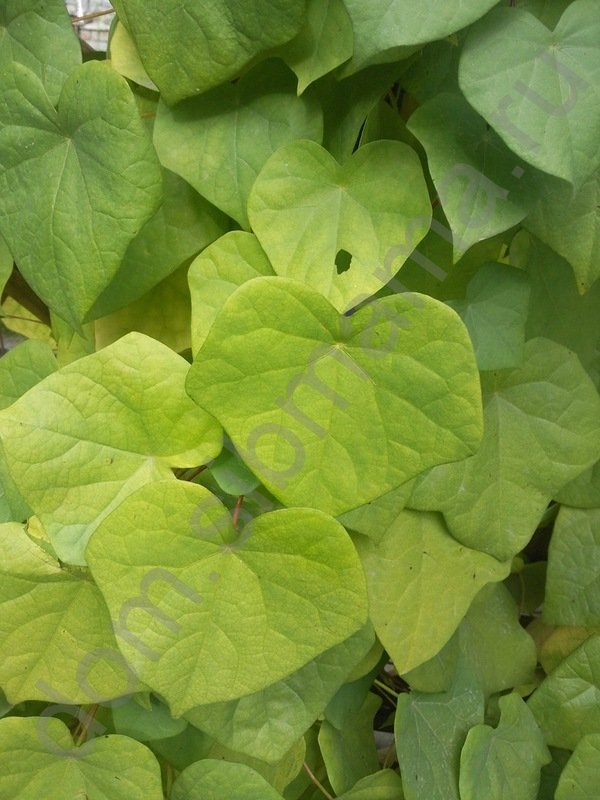
Lunosemyannik Dauri, Menispermum Daurian (Menispermum dauricum) - a perennial herbaceous, rhizomatous, dioecious plant 2-3 m high, with climbing stems. Rhizome yellow-brown, long, branched, with thin roots. The leaves are alternate, dense, dark green, thyroid or broadly heart-shaped, sometimes three or five-lobed. Flowers same-sex, small, greenish-yellow or greenish-pink, collected in axillary brush. The fruit is a drupe, black, globular, fleshy, with a flattened bone. It blooms in May - June. It grows on the edges of forests, rivers and streams in the Primorsky Territory, in the south of the Khabarovsk Territory, in Transbaikalia and in the southern regions of Eastern Siberia, near Irkutsk. This is the only plant from a very ancient Lunosemyan family that grows in our country. The rest of its species are found mainly only in the tropics and subtropics.
In Russia, unfortunately, it is rarely grown.
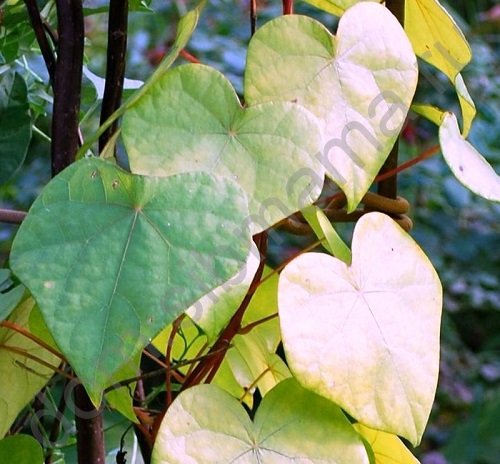
In the Novosibirsk region, the annual green grassy growth of a Lunosemyanik, without having time to woody, usually dies almost to the root collar, without actually forming a trunk, as a result, the ground part of the plant rarely grows longer than 2 m. However, this does not affect the winter hardiness of the plant as a whole. Its rhizomes, roots and buds of renewal, hidden in the ground, like those of the grassy perennials, are very cold and winter-hardy, therefore they do not die and in the spring they give shoots again.
In the southern part of the distribution range of increments that had matured and woody, which became grayish-brown, usually freezes to 20-40 cm only their uppermost end. Therefore, there Lunosemyannik grows in length to 5 m and even more.
The leaves are alternate, simple, dark green, thyroid, dense, smooth, leathery, with 3-7, usually 5 lobes, sometimes whole, up to 12 cm long, on long petioles. In autumn, the leaves become yellow-brown, very decorative. They look like ivy leaves.
Winter-hardy, resistant to spring and autumn frosts. But in the first years after landing, it is still desirable to shelter him for the winter in places where there is not enough snow. Resistant to diseases and pests. Gas and smoke resistant. Decorative effect becomes on the second or third year, when the shoots become numerous and quite long. It grows well in shady places. Propagated by seeds, root suckers, layering, cuttings, dividing the bush. Easy to run wild.

Lunosemyannik Daurian is a medicinal plant.
Harvest the grass during flowering; rhizomes with roots - in October.
Rhizomes contain alkaloids (2%): dauricin, tetrandrin, amutumin, acutuminin, menisphelin, raurinoline, synomenin. The content of alkaloids in grass and leaves is less than in rhizomes with roots.
It has anti-inflammatory, antipyretic and antihypertensive effects; reduces the excitability of the autonomic nervous system. In hypertension, dauricin lowers blood pressure, increases the amplitude of heart contractions, and relieves spasm of the coronary arteries.
Application.
Broth: 4-8 g of dry rhizomes and roots of a Lunosemyannik are boiled for 500 ml of water for 10 minutes, infused for 30 minutes, filtered. Take 100 ml 3-4 times a day for acute respiratory diseases, tonsillitis, gum disease, furunculosis, hemorrhoids, as well as for intestinal diseases.
Tincture: the roots and rhizomes of the Lunoseminnik insist on alcohol (1: 8) for 15 days, filter. Take 15-20 drops for hypertension.
Oil: crushed Lunosemyanik, mixed with vegetable oil, applied to the temples with a headache. A piece of Lunosemnik root is applied to a diseased tooth with a toothache.
LUNOSEMYANNIK DAURSKIY - Menispermum dauricum L
Lunosemyannikovye family - Menispermaceae Juss.
Lunosemyannik Daurian - grassy vine 2-5 m long. Stems are curly, wrapped around shrubs or grass, or lying (where there is no suitable support). In most parts of the Far East, the stalks are frosting to the ground, like those of ordinary herbaceous perennials, but in the Southern Primorye in shrub thickets there are specimens with a stem up to 3 m in length, frosting only 20-30 (50) cm. , corked, the diameter at the base of the stem 5-7 mm. The leaves are alternate, long-petiolate, thyroid, with 3-5 lobes, less often whole, 6-12 cm long, leathery, shiny. Plant dioecious. Flowers in short paniculate inflorescences, small, whitish-green. Fruits - black, juicy drupes up to 1 cm in diameter, with one large semi-lunar seed, with a dark purple juice, are poisonous. Seed with ribbed edge.
For therapeutic purposes, grass, roots, rhizomes and leaves are used. The plant contains 0.3% alkaloids: Acutumin, Acutumidine, Dauricin, Synomenin, Menisperin, Stefarin, Magnoflorin, Dauricinoline, as well as Berberine, tannins, resins, triterpene saponins and coumarins. In the leaves - alkaloids: synomenin, disinomenin, stearin, acutumin. The stalks and leaves contain coumarins and flavonoids.
Herbal infusion is used in Tibetan and Chinese medicine as a painkiller and diuretic for nephritis. The roots tincture was drunk as a means of tonic work of the gastrointestinal tract, improving metabolism, with endometritis and cholecystitis. Decoction of grass in Transbaikalia ethnoscience uses in gynecological diseases, as expectorant for pneumonia and diaphoretic in febrile conditions. Tincture and decoction of rhizomes reduce headache, reduce the excitability of the autonomic nervous system, improve health, increase efficiency.
Sinomenin has antipyretic effect. Drugs from the leaves of the Dahurian Lunosemyan reduce blood pressure and increase the amplitude of heart contractions, without having a significant effect on their rhythms.
It should be noted that the main active ingredient contained in the leaves is dauricin, and in the rhizomes - synomenin. Dauricin steadily lowers blood pressure and is recommended for the treatment of hypertension of I and II degrees. At the same time, the cholesterol content decreases and the amount of lecithin in the blood increases. Dauricin has 1/7 curare-like activity of tubokuranin. The synomene has anti-inflammatory effects and is promising for the treatment of rheumatism, back pain, abscesses and boils, as well as a general strengthening, hypotensive, sedative.
The plant is poisonous. There are cases of poisoning with berries, Lunosemyannik is one of the ornamental plants suitable for covering gazebos, fences and walls. However, taking into account the poisonousness of the fruit, only male specimens should be taken for planting.
Methods of preparation and use:
1. 2 tablespoons of dry crushed leaves per 200 ml of boiling water, leave for 2 hours, drain. Take 0.25 cup before meals 3 times a day for hypertension.
2. 2 tablespoons of the grass of the Daurian Lunosemyanika in 200 ml of water, boil over low heat, leave for 1 hour, drain. Take 0.25 cup for gynecological diseases, feverish conditions and as an expectorant for pneumonia.
3. 2 teaspoons of crushed dry roots for 1 cup of water, boil on low heat for 4-5 minutes, leave for 1 hour, drain. Take 2 tablespoons before meals 3-4 times a day.

